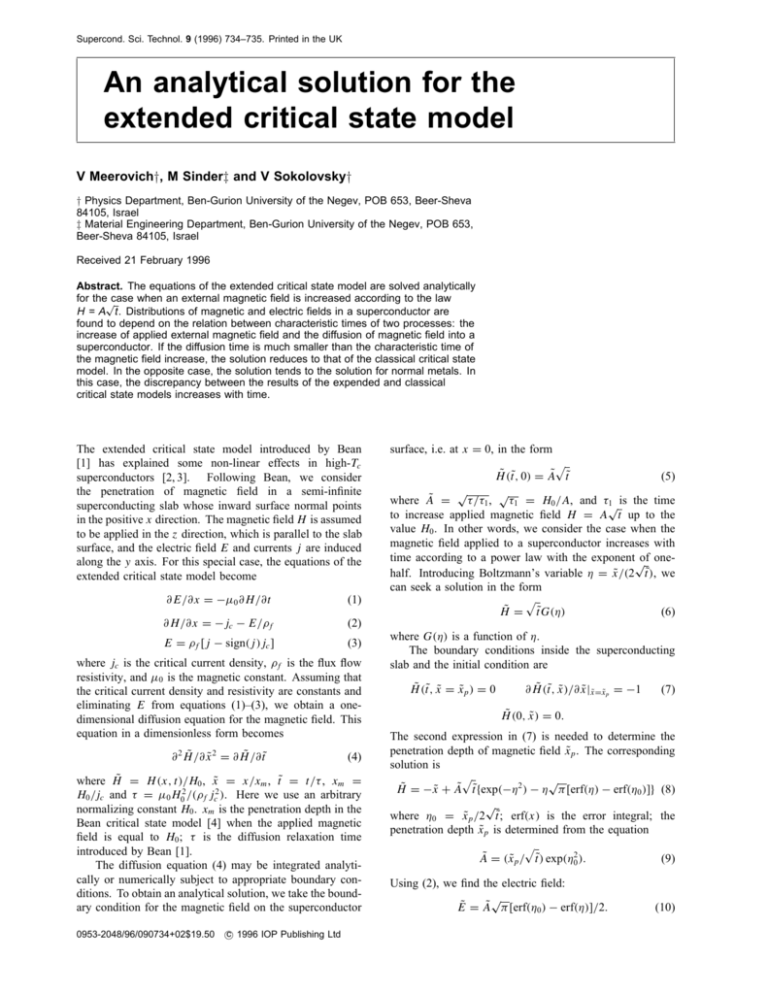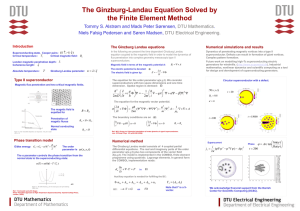An analytical solution for the extended critical state model
advertisement

Supercond. Sci. Technol. 9 (1996) 734–735. Printed in the UK
An analytical solution for the
extended critical state model
V Meerovich†, M Sinder‡ and V Sokolovsky†
† Physics Department, Ben-Gurion University of the Negev, POB 653, Beer-Sheva
84105, Israel
‡ Material Engineering Department, Ben-Gurion University of the Negev, POB 653,
Beer-Sheva 84105, Israel
Received 21 February 1996
Abstract. The equations of the extended critical state model are solved analytically
for the√case when an external magnetic field is increased according to the law
H = A t . Distributions of magnetic and electric fields in a superconductor are
found to depend on the relation between characteristic times of two processes: the
increase of applied external magnetic field and the diffusion of magnetic field into a
superconductor. If the diffusion time is much smaller than the characteristic time of
the magnetic field increase, the solution reduces to that of the classical critical state
model. In the opposite case, the solution tends to the solution for normal metals. In
this case, the discrepancy between the results of the expended and classical
critical state models increases with time.
The extended critical state model introduced by Bean
[1] has explained some non-linear effects in high-Tc
superconductors [2, 3]. Following Bean, we consider
the penetration of magnetic field in a semi-infinite
superconducting slab whose inward surface normal points
in the positive x direction. The magnetic field H is assumed
to be applied in the z direction, which is parallel to the slab
surface, and the electric field E and currents j are induced
along the y axis. For this special case, the equations of the
extended critical state model become
∂E/∂x = −µ0 ∂H /∂t
(1)
∂H /∂x = −jc − E/ρf
(2)
E = ρf [j − sign(j )jc ]
(3)
where jc is the critical current density, ρf is the flux flow
resistivity, and µ0 is the magnetic constant. Assuming that
the critical current density and resistivity are constants and
eliminating E from equations (1)–(3), we obtain a onedimensional diffusion equation for the magnetic field. This
equation in a dimensionless form becomes
∂ H̃ /∂ x̃ = ∂ H̃ /∂ t˜
2
2
(4)
where H̃ = H (x, t)/H0 , x̃ = x/xm , t˜ = t/τ , xm =
H0 /jc and τ = µ0 H02 /(ρf jc2 ). Here we use an arbitrary
normalizing constant H0 . xm is the penetration depth in the
Bean critical state model [4] when the applied magnetic
field is equal to H0 ; τ is the diffusion relaxation time
introduced by Bean [1].
The diffusion equation (4) may be integrated analytically or numerically subject to appropriate boundary conditions. To obtain an analytical solution, we take the boundary condition for the magnetic field on the superconductor
c 1996 IOP Publishing Ltd
0953-2048/96/090734+02$19.50 surface, i.e. at x = 0, in the form
p
H̃ (t˜, 0) = Ã t˜
(5)
√
√
where à = τ/τ1 , τ1 = H0 /A, and τ√
1 is the time
to increase applied magnetic field H = A t up to the
value H0 . In other words, we consider the case when the
magnetic field applied to a superconductor increases with
time according to a power law with the exponent√of onehalf. Introducing Boltzmann’s variable η = x̃/(2 t˜), we
can seek a solution in the form
p
H̃ = t˜G(η)
(6)
where G(η) is a function of η.
The boundary conditions inside the superconducting
slab and the initial condition are
H̃ (t˜, x̃ = x̃p ) = 0
∂ H̃ (t˜, x̃)/∂ x̃|x̃=x̃p = −1
(7)
H̃ (0, x̃) = 0.
The second expression in (7) is needed to determine the
penetration depth of magnetic field x̃p . The corresponding
solution is
p
√
H̃ = −x̃ + Ã t˜{exp(−η2 ) − η π [erf(η) − erf(η0 )]} (8)
√
where η0 = x̃p /2 t˜; erf(x) is the error integral; the
penetration depth x̃p is determined from the equation
p
(9)
à = (x̃p / t˜) exp(η02 ).
Using (2), we find the electric field:
√
Ẽ = Ã π [erf(η0 ) − erf(η)]/2.
(10)
An analytical solution for the extended critical state model
p
H̃ = Ã t˜ − x̃
p
Ẽ = Ã2 [1 − x̃/(Ã t˜)].
(11)
(12)
This solution is coincident with the solution given by the
critical state model: the current density is equal to the
critical one. The second member of the Taylor series is
proportional to Ã3 for H̃ and for Ẽ it is proportional to Ã4 .
In the other limiting case à 1, the penetration depth
is estimated as
q
x̃p ≈ 2 t˜ ln(Ã)
and the electric field becomes
√
Ẽ = (Ã π /2) erfc(η).
Figure 1. The penetration rate as a function of the
parameter Ã.
Figure 2. The distribution of the electric field inside a
superconductor for different values of Ã.
As follows from (10), the electric field on the
superconductor surface (η = 0) is time independent. The
distributions of magnetic and electric fields are determined
only by the parameter Ã. Figures 1 and 2 illustrate the
influence of the parameter à on the solutions.
Let us consider two limiting cases: (i) Ã 1 and
(ii) Ã 1. To analyse the first, we will expand the
solutions (8)–(10) in Taylor series in the parameter Ã. The
first member in the expansion for H̃ contains à with the
exponent of power equal to unity while the first member
in the expansion
√ for Ẽ is proportional to à squared. For
x̃ ≤ x̃p = Ã t˜, the magnetic and electric fields become
Note that, in contrast to the previous case, the electric
field is proportional to Ã, as for normal metals. The
electric field markedly differs from zero in the range where
η < 2–3. In deeper points of the superconductor, j ≈ jc
and the magnetic field decreases linearly as in the critical
state model. In proximity to the surface (η 1), the
electric field is close to a constant and the magnetic field
is determined by the expression
p
p
H̃ ≈ Ã t˜(1 − x̃/ t˜).
In conclusion, we have shown that the distribution form
of the magnetic and electric fields inside a superconductor
depends on the relation of the diffusion time τ and the
time τ1 , which characterizes an increase of the applied
magnetic field. For τ τ1 (Ã 1), the diffusion process
proceeds quickly and the solution differs little from that
given by the critical state model. For τ τ1 (Ã 1), the
magnetic field distribution is determined by the diffusion
process as in the case of normal metals. In the course
of time, the difference between solutions (8), (10) and the
critical state model increases (see figure 1). This result
differs critically from the results which have been obtained
in [5]. Ampere’s law used in the work referred to has a
form exactly equivalent to equation (2) but these treatments
did not use Faraday’s law (1).
References
[1] Bean C P 1989 Superconductivity and Applications ed H S
Kwok, Y-H Kao and D T Shaw (New York: Plenum)
p 767
[2] Jiang H and Bean C P 1994 Appl. Supercond. 2 689
[3] Fisher L M, Il’in N V, Voloshin I F et al 1993 Physica C
206 195
[4] Bean C P 1962 Phys. Rev. Lett. 8 250; 1964 Rev. Mod.
Phys. 36 31
[5] Liu Z and Bowden G J 1991 Supercond. Sci. Technol. 4 122
735







